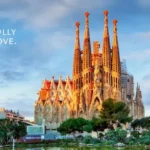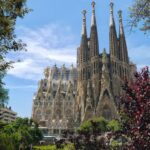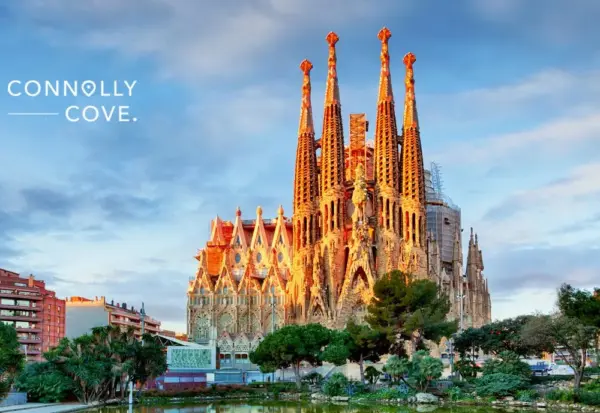
Barcelona is a city where architectural wonders come to life, and at the heart of it all stands the breathtaking Sagrada Familia. This iconic basilica, designed by the renowned architect Antoni Gaudí, is not just a testament to his genius but also a symbol of the city's rich cultural heritage.
Join us in Exploring the Majestic Sagrada Familia: A Captivating Barcelona Tour, where you will uncover the intricate details and profound stories behind this masterpiece. From its towering spires to its stunning facades, every corner of the Sagrada Familia invites visitors to marvel at its beauty and innovation.
Exploring the Architectural Wonders of the Sagrada Familia: A Barcelona Adventure
The Sagrada Familia is not only an architectural marvel but also a symbol of creativity and innovation. As you explore this grand basilica, you will encounter a fusion of Gothic and Art Nouveau styles, seamlessly blended to create a unique experience. Visitors are encouraged to take their time and appreciate the intricate details that Gaudí infused into every aspect of the structure.
One of the most captivating features of the Sagrada Familia is its stunning stained glass windows, which bathe the interior in a kaleidoscope of colors throughout the day. These windows tell biblical stories and enhance the spiritual atmosphere of the basilica. Make sure to look for:
- The vivid hues of blue and green in the Nativity façade
- The fiery reds and oranges in the Passion façade
- The serene light in the apse, creating a peaceful ambiance
As you embark on this Barcelona adventure, don't miss the chance to appreciate Gaudí's use of natural forms in the design. The basilica's columns resemble trees, creating an ethereal forest-like environment inside. This connection to nature is a hallmark of Gaudí’s work and is reflected in the organic shapes and textures throughout the Sagrada Familia.
Lastly, consider joining a guided tour for in-depth insights into the architectural wonders of the Sagrada Familia. Expert guides can illuminate the history and symbolism behind Gaudí's designs, making your visit even more enriching. With every stone and every curve narrating a story, your adventure in Barcelona is sure to be unforgettable.
The History Behind the Sagrada Familia: Gaudí's Vision for Barcelona
The Sagrada Familia's history is deeply intertwined with the vision of its architect, Antoni Gaudí. Commissioned in 1882, Gaudí took over the project in 1883 and dedicated the rest of his life to this monumental basilica. His ambition was not merely to create a church but to construct a comprehensive narrative of Christianity through architecture, using every element of the design to convey spiritual significance.
Gaudí envisioned the Sagrada Familia as a living organism, mirroring the natural world. He employed geometric shapes and organic forms, allowing the basilica to evolve with each passing year. The structure features an array of symbols, such as:
- The twelve apostles represented in the towers
- The Nativity façade depicting the birth of Christ
- The Passion façade illustrating the crucifixion
Despite Gaudí's intense dedication, the Sagrada Familia remains unfinished, with an expected completion date of 2026, coinciding with the centenary of Gaudí's death. This ongoing work is a testament to the enduring nature of his vision, as teams of architects and craftsmen continue to strive toward Gaudí's original designs, ensuring the basilica remains a symbol of Barcelona for generations to come.
The influence of Gaudí's vision extends beyond just the Sagrada Familia; it has ignited a passion for modernist architecture throughout Barcelona. His work has inspired countless artists and architects, solidifying his legacy as a pioneer of the 20th century. As you visit the Sagrada Familia, you are not just witnessing a building, but an epic story of creativity, faith, and cultural identity.
Tips for an Unforgettable Sagrada Familia Tour: What You Need to Know
To make the most of your visit to the Sagrada Familia, it’s essential to plan ahead. Consider purchasing your tickets online to avoid long queues and ensure you have ample time to explore this architectural marvel. Additionally, choosing the right time for your visit can greatly enhance your experience:
- Early morning or late afternoon visits tend to be less crowded.
- Weekdays are generally quieter than weekends.
- Special sunrise or sunset tours offer a unique perspective of the basilica.
Don't forget to take advantage of the audio guides available on-site. These guides provide valuable insights into Gaudí's vision, the intricate details of the architecture, and the historical context that surrounds the Sagrada Familia. With the right guidance, you can appreciate the basilica's beauty on a deeper level.
Another tip for an unforgettable tour is to explore the surrounding area after your visit. The Sagrada Familia is located in a vibrant neighborhood with plenty of coffee shops and restaurants. Enjoy a meal or a drink while reflecting on your experience. Consider trying:
- Local tapas at nearby restaurants.
- Refreshing drinks at cafes with views of the basilica.
- Traditional Catalan desserts to complete your culinary adventure.
Lastly, be sure to take your time. Rather than rushing through, allow yourself to absorb the stunning details of the Sagrada Familia. From the towering facades to the delicate sculptures, every element tells a story, and your visit will be all the more memorable if you savor each moment.
Discover the Symbolism of the Sagrada Familia: Insights into its Design
The Sagrada Familia is steeped in symbolism, reflecting Gaudí's deep connection to his faith and the natural world. Each element of its design serves a purpose, conveying profound spiritual messages. The basilica is structured around the concept of unity and harmony, showcasing how each feature contributes to the whole, much like the various components of nature. As you delve into its design, you will discover layers of meaning that bring the architectural narrative to life.
One of the key symbols within the Sagrada Familia is the use of light. Gaudí designed the basilica to interact with sunlight, allowing it to change throughout the day, creating a dynamic spiritual experience. This play of light is most evident in the stained glass windows, which not only illustrate biblical stories but also evoke emotional responses, illustrating the presence of the divine in everyday life. Visitors should pay attention to:
- The transition of colors as the sun moves across the sky
- How natural light enhances the interior spaces
- The role of color in conveying different moods and themes
The towers of the Sagrada Familia, representing the twelve apostles, are another significant aspect of its symbolism. Each tower is uniquely designed to reflect the characteristics of its namesake, allowing visitors to connect with the narrative of Christianity on a more personal level. Gaudí's intention was for these towers to reach towards the heavens, symbolizing the bridge between the earthly realm and the divine. This vision invites pilgrims and tourists alike to contemplate their own spiritual journeys.
Ultimately, the Sagrada Familia stands not just as a remarkable feat of engineering but as a spiritual testament to Gaudí's innovative mind. By embracing symbolism throughout its design, the basilica serves as a constant reminder of the relationship between faith, nature, and humanity. Each visit offers an opportunity to reflect on these themes, making your exploration of this iconic basilica an unforgettable experience.
Best Times to Visit the Sagrada Familia: A Complete Guide for Tourists
When planning your visit to the Sagrada Familia, timing is key to experiencing its awe-inspiring beauty without the overwhelming crowds. The best times to visit are generally in the early morning or late afternoon, when the sun casts a warm glow on the stunning facades. This timing not only allows you to enjoy the basilica in a quieter atmosphere but also enhances your experience of the intricate details that Gaudí designed to interact with natural light.
In terms of seasonal visits, consider coming during the shoulder seasons of spring (March to May) or fall (September to November). During these months, the weather is pleasant, and tourist numbers are lower compared to the peak summer season. This enables you to explore the Sagrada Familia more freely while absorbing its magnificent architecture. Additionally, weekday visits tend to be less crowded than weekends, allowing for a more tranquil experience.
Special tours are also available during sunrise and sunset, which offer a unique perspective of the Sagrada Familia. The beautiful play of light at these times adds a magical touch to your visit, as the changing colors of the sky enhance the already vibrant stained glass windows. If you're interested, be sure to book these tours in advance, as they can fill up quickly, especially during peak travel seasons.
Lastly, keep in mind that the Sagrada Familia is a working church, and there may be times when services or events affect visitor access. Checking the official schedule before your visit can help you avoid any interruptions and ensure a fulfilling experience at this iconic landmark. Remember, visiting the Sagrada Familia is not just about seeing a building; it's about embracing a piece of Barcelona's cultural heritage.
Experience the Sagrada Familia: Essential Information for Your Barcelona Visit
When preparing for your visit to the Sagrada Familia, it's crucial to gather some essential information to enhance your experience. Firstly, consider booking your tickets in advance to skip the long queues and secure your preferred time slot. Additionally, familiarize yourself with the basilica's opening hours, which vary depending on the season. Generally, the Sagrada Familia is open from 9 AM to 8 PM, but checking the official website for specific details is advisable.
One of the best ways to truly immerse yourself in the Sagrada Familia is by opting for a guided tour. This option allows you to gain insights from expert guides who can share the rich history and intricate details of Gaudí's masterpiece. Many tours also include access to areas that are not open to the general public, providing a more in-depth exploration of the basilica’s architectural wonders.
As you navigate your way through the Sagrada Familia, take a moment to appreciate the stunning surroundings. The basilica is situated in a vibrant area with numerous amenities for visitors. After your tour, consider exploring nearby attractions and indulging in local cuisine. You can find:
- Charming cafes offering traditional pastries
- Restaurants serving authentic Spanish tapas
- Gift shops featuring unique Gaudí-inspired souvenirs
Finally, be sure to allocate enough time for your visit. Each detail of the Sagrada Familia tells a story, and rushing through may cause you to miss its profound beauty. Spend time gazing at the intricate carvings and the remarkable play of light within the basilica, making your visit an unforgettable part of your Barcelona adventure.
 The Majestic Barcelona Towers: Exploring the Magic of Sagrada Familia
The Majestic Barcelona Towers: Exploring the Magic of Sagrada Familia The Completed Masterpiece: Sagrada Familia in Barcelona
The Completed Masterpiece: Sagrada Familia in BarcelonaIf you want to know other articles similar to Exploring the Majestic Sagrada Familia: A Captivating Barcelona Tour you can visit the category WHERE YOU CAN GO.
Leave a Reply










Read more!